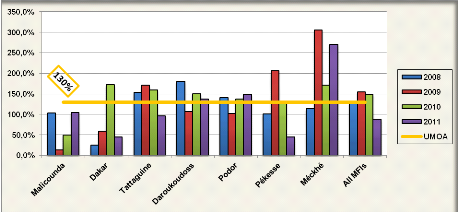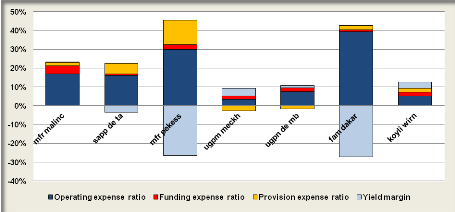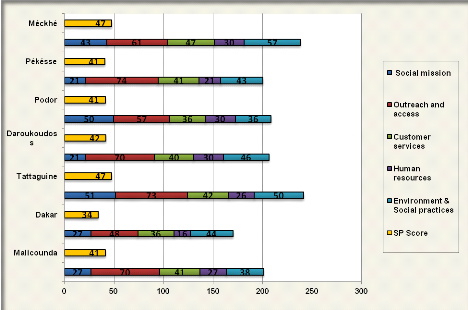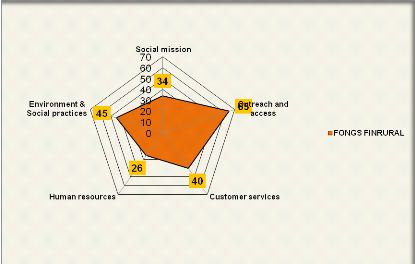5.1.4.2 Operational self sufficiency: struggling to
survive
Operational self sufficiency appears as on key element of an
MFI performance. Measuring the extent to which a MFI can cover its ordinary
cost through operating income, it helps to evince whether a given MFI can
sustain without any subsidy. The figure 13 reveals the operational self
sufficiency of the seven MFIs over the past four year.
Figure 13: Operational Self
Sufficiency 2008-2011

Source: Our survey (may-august
2012)
The surveyed MFIs show up different features of OSS over time.
While some have reached the OSS and continue keeping the trend, others continue
striving to reach the OSS.
For example, the figure 13 underscores that for the last four
years OSS of the MEC MFR of Malicounda fluctuated tremendously between 103% and
104% whereas the MEC FAM of Dakar recorded only once a ratio higher than 100%
(in 2010). In the industry and specifically in UMOA region, a minimum
threshold of 130% is required to become really operationally self sufficient.
As consequence, the two MFIs cannot really survive without any donation or
subsidy. However since 2009, the operational self sufficiency ratio of
Malicounda is increasing showing some improvement.
The MEC SAPP of Tattaguine and MFR of Pékésse
recorded in 2011 a very low operational self sufficiency ratio (96% and 44%
respectively) due mainly their aforementioned administrative and personal
expenses.
The CREC of Méckhé sustained its OSS over 130%
during the last three years implying its ability to operate without any kind of
donation.
The case of the MEC FAM is mainly due to its operating areas,
urban and peri-urban. It is the only one MFI of the network operating with
headquarters in Dakar, the capital city of the Senegal. Therefore personnel
expenses might be higher than the other operating in rural areas as shown
through the figure 14.
Figure 14: Breakdown of
portfolio yield 2011

Source: Our survey (may-august
2012)
The figure 14 shows indeed that the MEC of Dakar reported the
highest operating expenses ratio compared with its peers; entailing then a
negative yield margin.
Considering the network as a whole, after having recorded very
high operational self sufficiency ratios in 2009 and 2010 (figure 13), the
operational self sufficiency of the entire seven MFIs is about 88% in 2011,
showing that the network still need subsidy to operate properly. This ratio is
mainly affected by the high operating expenses but very low financial
performances of the MEC of Tattaguine and Pékesse which contributed of
about 27% and 30% severally to the expenses of the entire network in 2011.
5.2 Social performance Analysis
Since 2000, miscellaneous initiatives were developed around
the world to improve the social performance measurement and management which
are perceived as the real implementation of social goals of MFIs (Hashemi,
2007:3 quoted by Bédécarrats, Baur & Lapennu, 2011). The
social performance measurement helps at assessing an MFI's social performance
as it permits to identify the level of application the social mission of an MFI
(Dewez & Neisa, 2009). It also helps at improving reciprocal trust, client
participation and satisfaction. As consequence, MFIs record higher repayment
rates and low their transactions costs (Lapenu, 2007 quoted by
Bédécarrats, Baur & Lapenu, 2011).
The social performance analysis is mainly based on the
ECHOS(c) tool of Incofin and includes five main dimensions: social mission
management, outreach and access, quality of customers (members) service in
compliance with client protection principles, human resources management,
environment and corporate social responsibility. The main intention was not to
assess and grade the social performance of the MFIs, rather the tool helped us
to have a sound insights on the situation among FONGS FINRURAL Network
affiliated MFIs as far as social performance is concerned.
The figures 15 and 16 hereafter shows FONGS FINRURAL network
affiliated MFIs.
Figure 15: Social
Performances of the Seven MFIs

Source: Our survey (may-august
2012)
All the seven MFIs recorded social performance scores under
55% (based on ECHOS(c) scale) meaning a low social performance situation.
The MEC SAPP of Tattaguine and the CREC of
Méckhé recorded the highest score (47% each one) whereas the MEC
FAM of Dakar recorded the lowest score (34%).
All the seven MFIs present good scores in outreach an access
(65% in average). This is due mainly to their access conditions which are
competitive (affordable shares for membership, low cost for adhesion) and the
targeted area. Some MFIs are sole in their operational areas (Malicounda)
whilst others have opened additional periodic branches (SAP and FAM). This
finding corroborates Angora, Bédécarrats & Lapenu (2009) for
who sub Sahara MFIs tend to perform better in people targeting.
Figure 16: Social
performance of FONGS FINRURAL

Source: Our survey (may-august
2012)
In the opposite, low scores are observed in social mission and
human resources management (34% and 26% respectively). MFIs are perceived as
financial levers of mother associations and their missions are supposed to be
ingrained in the social mission of development associations. However the social
missions of the seven MFIs are not clearly stated with key indicators people
could track. The lack of training and information regarding social management
is one of the causes of the situation. Moreover, the staffs of these
self-managed MFIs are most often hired within local human resources, are
unqualified even if they hold strong records in the field of microfinance.
Their position is mainly perceived as volunteer services. Nevertheless, the
staff rotation is really low as the staff members are also members of the MFIs.
In addition, the overall score in customer services dimension
is low (26) despite of the adapted products delivery. This might be due to the
non provision of diversified products such as Business development services,
insurance, remittances etc... The provision of BDS is mainly assumed by the
mother associations which officers are involved in the devising of members or
households investment projects, their follow up and loans repayment monitoring
as well. But these services are only limited to members which belong to both
MFI and mother association. Moreover, the MFIs assets level might not be
sufficient to get involved in the provision of others products.
The CREC UGPM of Méckhé recorded the highest
score in services to customers (57%) because of their experience in solar
energy loans in partnership with KAYER.
For the last dimension, social practices and environment, the
MFIs are not trained enough to include environmental dimension in their credit
policies. Nevertheless, credit committees are aware that they should not grant
loan for activities that may damage the environment. Rather, MFIs are striving
to have access to some credit line to finance solar energy and biogas.
| 


